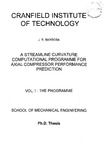JavaScript is disabled for your browser. Some features of this site may not work without it.
| dc.contributor.advisor | Ramsden, K. W. | |
| dc.contributor.author | Barbosa, J. R. | |
| dc.date.accessioned | 2015-01-29T14:41:47Z | |
| dc.date.available | 2015-01-29T14:41:47Z | |
| dc.date.issued | 1987-09 | |
| dc.identifier.uri | http://dspace.lib.cranfield.ac.uk/handle/1826/9111 | |
| dc.description.abstract | Accurate prediction of overall performance is vital if the extremely high design and development costs of modern high speed compressors are to be minimised. This fact, which is not novel, has led to the development of many computer programmes for such prediction. However, the most useful of these are proprietary. Some of those that are accessible in the open literature are of limited application to high performance axial compressors. This is mainly because they cannot reliably handle the transonic flows which characterise modern designs; nor are they generally easy to use from an interactive stand point. Accordingly, this report describes the origination of a streamline curvature programme for compressor performance prediction which attempts to bridge the gap in the existing literature base. The correlations used allow the package to be applied to more recent compressors at the highest level of the technology. In general, the programme is both interactive and fully modular. The former makes it easy for the user to access the programme quickly and effectively whilst the latter facilitates the use, for example, of alternative loss and deviation models to those prescribed within the programme. A further important feature of this new programme is its flexibility. For example, it can be used in three modes: firstly, as an analysis programme for performance prediction of compressors of known geometry; secondly, as a design/development tool to assess the likely performance changes occasioned by the introduction of geometrical variations in both blading and annulus shape; thirdly, as a straight design programme for new compressors provided a project analysis has been carried out beforehand. In the first two modes of operation, the programme requires details of standard blading, annulus geometry, design mass flow and pressure ratio. In the third, the user is free to prescribe his own blade shapes. The combined features described were introduced to make the package an ideal teaching tool. In this respect it should be emphasised that the complete novice to axial compressor design and performance assessment would experience difficulties using the package. However, the user who has some background, perhaps through lectures or in an appropriate industrial environment would quickly become adept. Against this background, whilst the programme is very interactive, it cannot claim, in its own right, to be an Expert System. The latter capability, however, can with some development easily be built in at a later stage. In order to minimise the time required accessing the programme, the report includes a comprehensive "user- guide". The validity of the prediction method is tested against an actual transonic compressor of known performance. The output is various and includes graphical presentation of all significant design/performance parameters throughout the compressor, including the compressor overall characteristic. | en_UK |
| dc.language.iso | en | en_UK |
| dc.publisher | Cranfield University | en_UK |
| dc.title | Streamline curvature computational programme for axial compressor performance prediction | en_UK |
| dc.type | Thesis or dissertation | en_UK |
| dc.type.qualificationlevel | Doctoral | en_UK |
| dc.type.qualificationname | PhD | en_UK |
